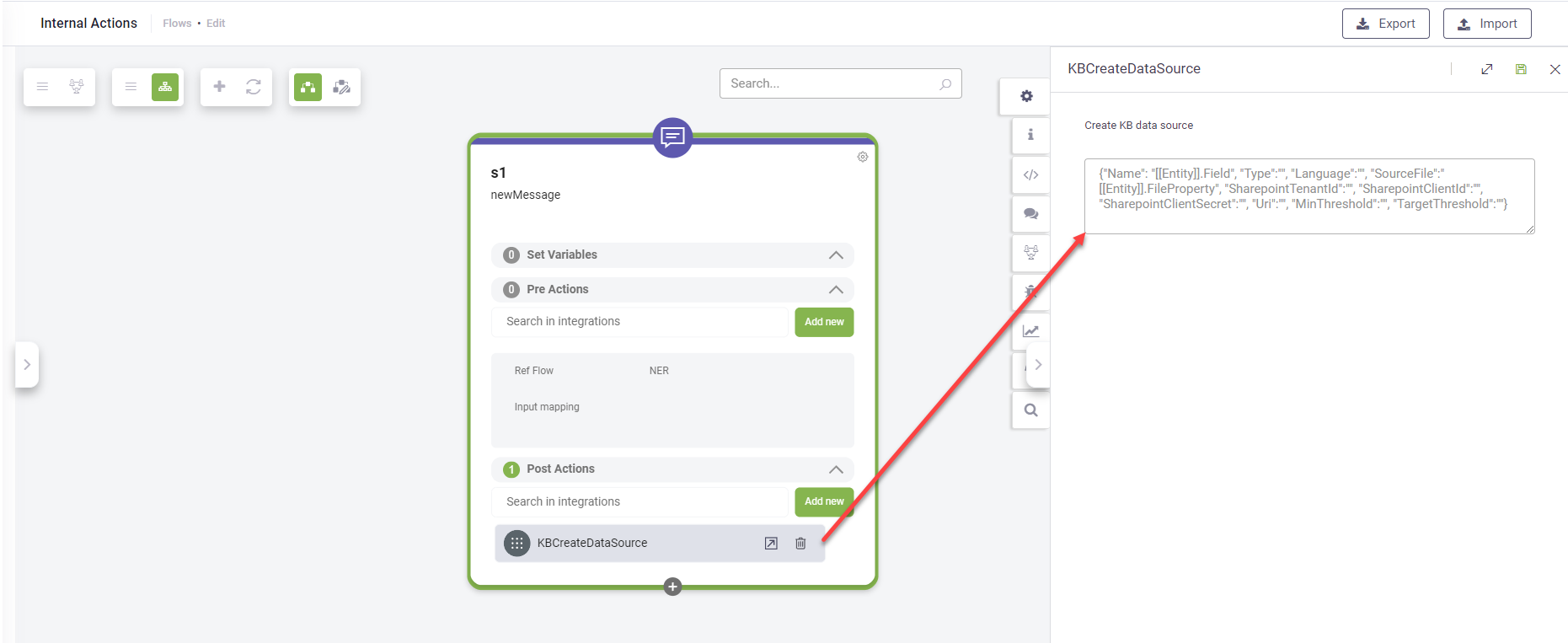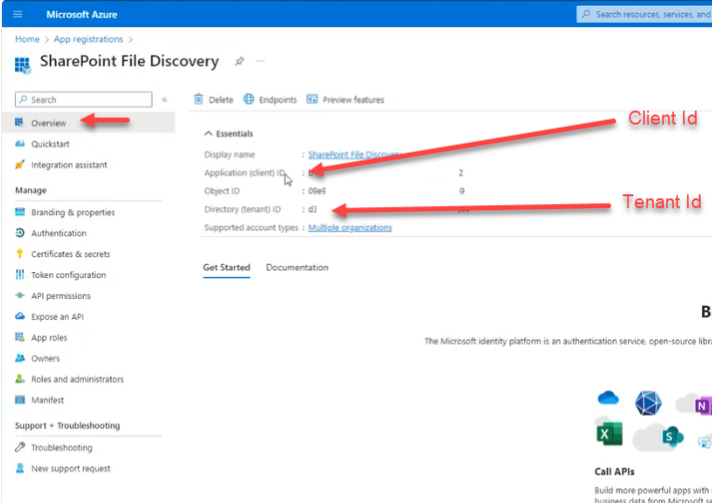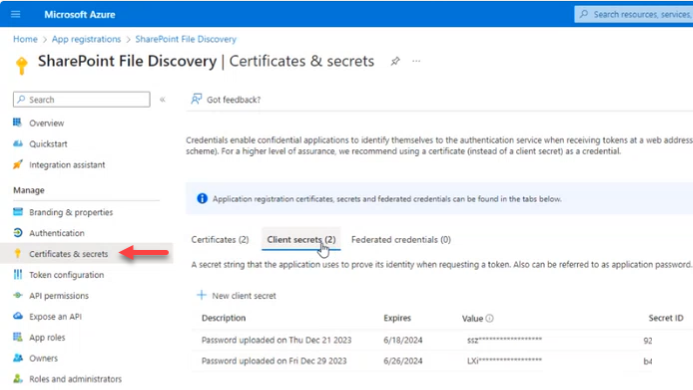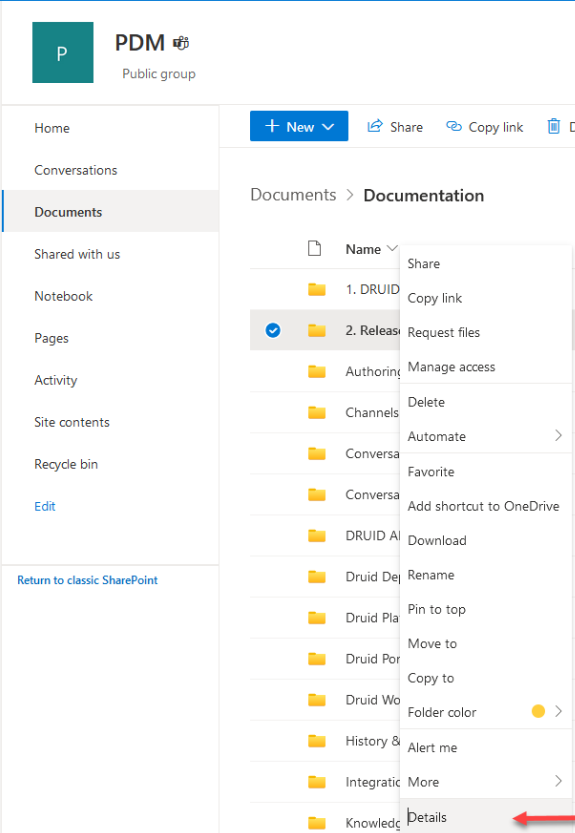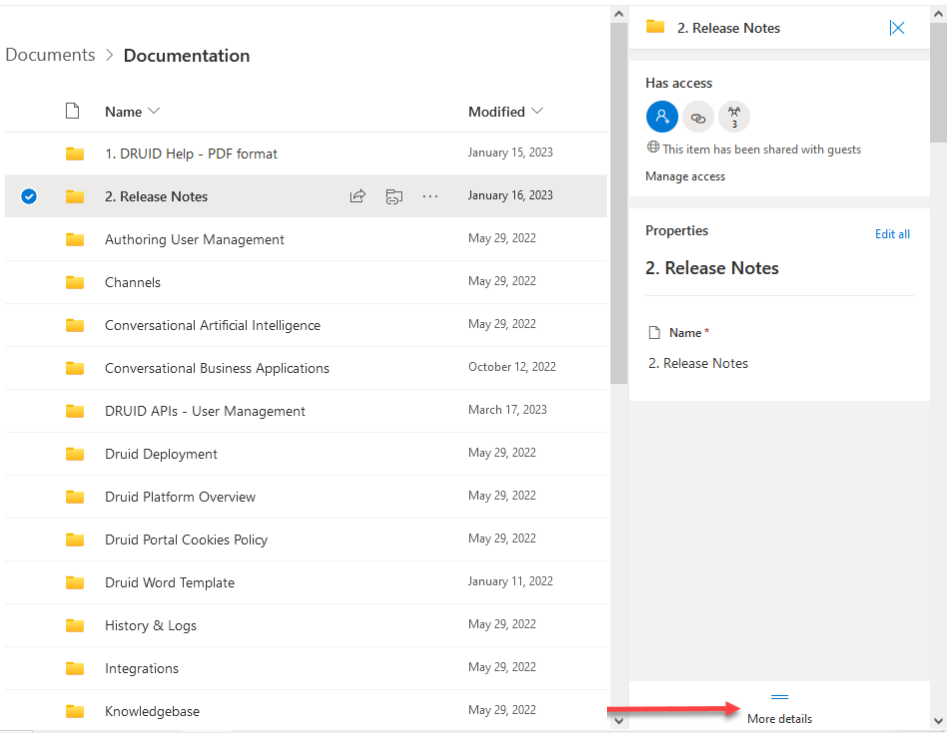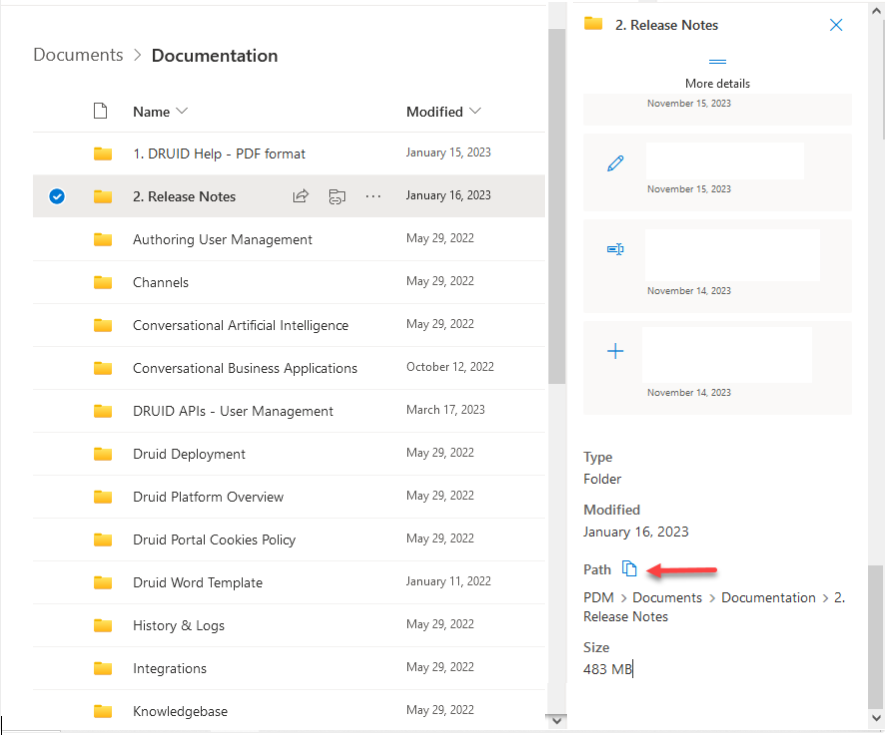KB Management at Conversation Time
You can perform Knowledge Base operations directly within your conversational flows using KB-specific internal actions. These actions enable you to:
- Create, edit, and delete KB data sources directly within your conversational flows.
- Easily edit existing data sources to ensure accuracy and relevance.
- Extract content from documents or URLs to enrich the KB with valuable information.
- Efficiently train the KB to improve its performance and responsiveness.
Create data sources from files
Create a data source from structured Excel and PDF files by using the internal action KBCreateDataSource.
Syntax
{
"Name":"[[Entity]].Field",
"Type":"string",
"Language":"string",
"SourceFile":"[[Entity]].FileProperty",
"MinThreshold":"string",
"TargetThreshold":"string"
}
| Parameter | Description |
|---|---|
| Name | The new name of the data source (hardcoded, stored in a variable or entity field). This parameter is mandatory. |
| Type | The data source type: File repository. |
| Language | The language of the data you upload. It must be one of the bot languages. |
| SourceFile | The entity field of type File that stores the data source file (Excel or PDF). |
| MinThreshold | The minimum acceptable score for content extraction. |
| TargetThreshold | The desired score threshold for content extraction. This threshold determines the level of confidence required for the extracted content to be considered relevant and accurate. |
Create data sources from SharePoint Online
Extract question and answer pairs from Excel, Word, and PDF documents within a SharePoint site library using the internal action KBCreateDataSource.
Prerequisites
- Reach out to your company's Microsoft Azure subscription administrator and ask for the following Microsoft Azure details: Tenant Id, Client Id and Client Secret.
- Your company's Microsoft Azure subscription administrator should check and ensure that the API permissions provided in the figure below are granted in Microsoft Azure.
Syntax
Syntax
{
"Name": "[[Entity]].Field",
"Type": "",
"Language": "",
"SharepointTenantId": "",
"SharepointClientId": "",
"SharepointClientSecret": "",
"Uri": "",
"MinThreshold": "",
"TargetThreshold": ""
}
| Parameter | Description |
|---|---|
| Name | The new name of the data source (hardcoded, stored in a variable or entity field). |
| Type | The data source type SharePoint. |
| Language | The language of the data. It must be one of the bot languages. |
| SharepointTenantId | The Tenant Id you received from your MS Azure administrator. |
| SharepointClientId | The Client Id you received from your MS Azure administrator. |
| SharepointClientSecret | The Client Secret you received from your MS Azure administrator. |
| Uri |
The SharePoint content location (SharePoint library) from which DRUID will extract data. To find the SharePoint Content Location (Uri): |
| MinThreshold | The minimum acceptable score for content extraction. |
| TargetThreshold | The desired score threshold for content extraction. This threshold determines the level of confidence required for the extracted content to be considered relevant and accurate. |
| DisableCertificate | Set to "False" to authenticate using a SharePoint client secret instead of a DRUID-generated certificate. |
Create data sources from SharePoint 2019
Extract paragraphs from documents stored in SharePoint 2019 libraries using the internal action KBCreateDataSource.
Syntax
Syntax
{
"Name":"[[Entity]].Field",
"Type":"string",
"Language":"en-US",
"Uri":"string”,
"MinThreshold": "string",
"TargetThreshold": "string",
“UserName”:”string”,
“Password”:”string”,
“SourceType”:”Sharepoint 2019”
}
| Parameter | Mandatory for | Description |
|---|---|---|
| Name | File repository, SharePoint online, Shared drive | The new name of the data source (hardcoded, stored in a variable or entity field). This parameter is mandatory. |
| Type | File repository, SharePoint online, Shared drive | The data source type: Sharepoint. |
| Language | File repository, SharePoint online, Shared drive | The language of the data you upload. It must be one of the bot languages. |
| Uri | SharePoint online, Shared drive | The SharePoint content location (SharePoint library) from which DRUID will extract data. |
| MinThreshold | File repository, SharePoint online, Shared drive | The minimum acceptable score for content extraction. |
| TargetThreshold | File repository,SharePoint online, Shared drive | The desired score threshold for content extraction. This threshold determines the level of confidence required for the extracted content to be considered relevant and accurate. |
| UserName | Shared drive, SharePoint 2019 | The SharePoint username. |
| Password | Shared drive, SharePoint 2019 | |
| SourceType | SharePoint | Sharepoint 2019. |
Create data sources from Network Shared Drive
Extract paragraphs from documents stored in network shared drive using the internal action KBCreateDataSource.
Syntax
Syntax
{
"Name":"[[Entity]].Field",
"Type":"string",
"Language":"en-US",
"Uri":"string”,
"MinThreshold": "string",
"TargetThreshold": "string",
“StoreType”:”string”,
“Host”:”string”,
“UserName”:”string”,
“Password”:”string”,
“Port”:”string”,
}
| Parameter | Mandatory for | Description |
|---|---|---|
| Name | Shared drive | The new name of the data source (hardcoded, stored in a variable or entity field). This parameter is mandatory. |
| Type | Shared drive | The data source type: Shared drive. |
| Language | Shared drive | The language of the data you upload. It must be one of the bot languages. |
| Uri | Shared drive |
Provide the Uri based on the data source type and storage type, as follows:
|
| MinThreshold | Shared drive | The minimum acceptable score for content extraction. |
| TargetThreshold | Shared drive | The desired score threshold for content extraction. This threshold determines the level of confidence required for the extracted content to be considered relevant and accurate. |
| StoreType | Shared drive | The storage type: Local File, Local Share, FTP or SFTP. |
| Host | Shared drive (FTP/SFTP) |
The host name of the SFTP server. |
| UserName | Shared drive (FTP/SFTP) | The FTP/SFTP login ID for Shared drive data sources. |
| Password | Shared drive (FTP/SFTP) | The SFTP login password. |
| Port | Shared drive (FTP/SFTP) | The host name of the FTP/SFTP server. |
Delete data sources
Delete a specific data source from the KB using the internal action KBDeleteDataSource.
| Parameter | Description |
|---|---|
| DataSourceId | The Id of the data source (hardcoded, stored in a variable or entity field). This field is mandatory. |
Update data sources
Update a specific data source in the KB using the internal action KBEditDataSource.
{
"DataSourceId":"[[Entity]].Field",
"SourceFile":"[[Entity]].FileProperty",
"Name":"string",
"Uri":"string",
"SharepointTenantId":"string",
"SharepointClientId":"string",
"SharepointClientSecret":"string",
"MinThreshold":"string",
"TargetThreshold":"string",
"StoreType":"string",
"Host":"string",
"UserName":"string",
"Password":"string",
"DisableCertificatValidation":"string",
"Port""string"
}Each data source type has unique settings you can adjust to keep your knowledge base (KB) data accurate and up-to-date. Here’s what you can edit for each data source type:
- For a data source of type File (Excel or PDF), you can:
- Edit the name
- Upload a new source file
- Update extraction thresholds
- For a data source of type SharePoint, you can:
- Edit SharePoint credentials (Tenant ID, Client ID, and Client Secret)
- Update extraction thresholds
- For a data source of type Shared Drive (FTP/SFTP), you can:
- Edit the host and port
- Update FTP/SFTP login credentials (ID and password)
- Update extraction thresholds
| Parameter | Data source type | Description |
|---|---|---|
| DataSourceId | all | The Id of the data source (hardcoded, stored in a variable or entity field). This field is mandatory. |
| Name | all | The new name of the data source if want to update the name. |
| SourceFile | File Repository | The new data source file you want to upload, which is hardcoded or stored in a variable or entity field of type 'File'. |
| SharepointTenantId | SharePoint online | The new Tenant Id you received from your MS Azure administrator. |
| SharepointClientId | SharePoint online | The new Client Id you received from your MS Azure administrator. |
| SharepointClientSecret | SharePoint online | The new Client Secret you received from your MS Azure administrator. |
| Uri | SharePoint online, Shared drive |
The Uri based on the data source type and storage type, as follows:
|
| MinThreshold | File repository, SharePoint online, Shared drive | The minimum acceptable score for content extraction. |
| TargetThreshold | File repository,SharePoint online, Shared drive | The desired score threshold for content extraction. This threshold determines the level of confidence required for the extracted content to be considered relevant and accurate. |
| StoreType | Shared drive | The storage type: Local File, Local Share, FTP or SFTP. |
| Host | Shared drive (FTP/SFTP) |
The host name of the SFTP server. |
| UserName | Shared drive, SharePoint 2019 | The FTP/SFTP login ID for Shared drive data sources or the username for SharePoint on premises. |
| Password | Shared drive, SharePoint 2019 | The SFTP login password or the password for SharePoint on premises. |
| DisableCertificatValidation | SharePoint online | Set to "true" to authenticate using a SharePoint client secret instead of a DRUID-generated certificate. |
| Port | Shared drive (FTP/SFTP) | The host name of the FTP/SFTP server. |
Train the KB
Train the KB after adding / updating a specific data source using the KBTrain internal action.
| Parameter | Description |
|---|---|
| DataSourceId | The Id of the data source that was added/updated (hardcoded, stored in a variable or entity field). This field is mandatory. |
